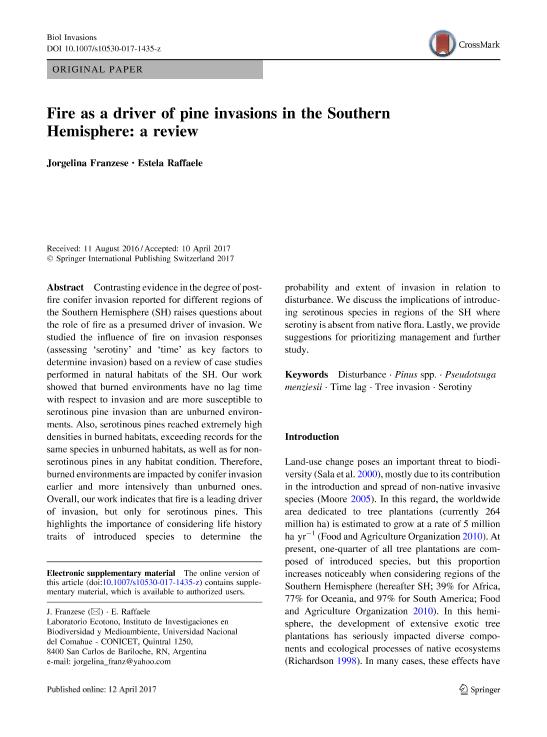Mostrar el registro sencillo del ítem
dc.contributor.author
Franzese, Jorgelina

dc.contributor.author
Raffaele, Estela

dc.date.available
2018-09-06T14:13:52Z
dc.date.issued
2017-08
dc.identifier.citation
Franzese, Jorgelina; Raffaele, Estela; Fire as a driver of pine invasions in the Southern Hemisphere: a review; Springer; Biological Invasions; 19; 8; 8-2017; 2237-2246
dc.identifier.issn
1387-3547
dc.identifier.uri
http://hdl.handle.net/11336/58490
dc.description.abstract
Contrasting evidence in the degree of post-fire conifer invasion reported for different regions of the Southern Hemisphere (SH) raises questions about the role of fire as a presumed driver of invasion. We studied the influence of fire on invasion responses (assessing ‘serotiny’ and ‘time’ as key factors to determine invasion) based on a review of case studies performed in natural habitats of the SH. Our work showed that burned environments have no lag time with respect to invasion and are more susceptible to serotinous pine invasion than are unburned environments. Also, serotinous pines reached extremely high densities in burned habitats, exceeding records for the same species in unburned habitats, as well as for non-serotinous pines in any habitat condition. Therefore, burned environments are impacted by conifer invasion earlier and more intensively than unburned ones. Overall, our work indicates that fire is a leading driver of invasion, but only for serotinous pines. This highlights the importance of considering life history traits of introduced species to determine the probability and extent of invasion in relation to disturbance. We discuss the implications of introducing serotinous species in regions of the SH where serotiny is absent from native flora. Lastly, we provide suggestions for prioritizing management and further study.
dc.format
application/pdf
dc.language.iso
eng
dc.publisher
Springer

dc.rights
info:eu-repo/semantics/openAccess
dc.rights.uri
https://creativecommons.org/licenses/by-nc-sa/2.5/ar/
dc.subject
Disturbance
dc.subject
Pinus Spp
dc.subject
Pseudotsuga Menziesii
dc.subject
Serotiny
dc.subject
Time Lag
dc.subject
Tree Invasion
dc.subject.classification
Otras Ciencias Biológicas

dc.subject.classification
Ciencias Biológicas

dc.subject.classification
CIENCIAS NATURALES Y EXACTAS

dc.title
Fire as a driver of pine invasions in the Southern Hemisphere: a review
dc.type
info:eu-repo/semantics/article
dc.type
info:ar-repo/semantics/artículo
dc.type
info:eu-repo/semantics/publishedVersion
dc.date.updated
2018-08-31T13:47:51Z
dc.journal.volume
19
dc.journal.number
8
dc.journal.pagination
2237-2246
dc.journal.pais
Alemania

dc.journal.ciudad
Berlin
dc.description.fil
Fil: Franzese, Jorgelina. Consejo Nacional de Investigaciones Científicas y Técnicas. Centro Científico Tecnológico Conicet - Patagonia Norte. Instituto de Investigaciones en Biodiversidad y Medioambiente. Universidad Nacional del Comahue. Centro Regional Universidad Bariloche. Instituto de Investigaciones en Biodiversidad y Medioambiente; Argentina
dc.description.fil
Fil: Raffaele, Estela. Consejo Nacional de Investigaciones Científicas y Técnicas. Centro Científico Tecnológico Conicet - Patagonia Norte. Instituto de Investigaciones en Biodiversidad y Medioambiente. Universidad Nacional del Comahue. Centro Regional Universidad Bariloche. Instituto de Investigaciones en Biodiversidad y Medioambiente; Argentina
dc.journal.title
Biological Invasions

dc.relation.alternativeid
info:eu-repo/semantics/altIdentifier/doi/https://dx.doi.org/10.1007/s10530-017-1435-z
dc.relation.alternativeid
info:eu-repo/semantics/altIdentifier/url/https://link.springer.com/article/10.1007%2Fs10530-017-1435-z
Archivos asociados
